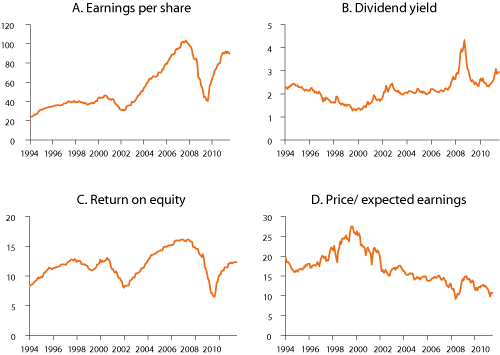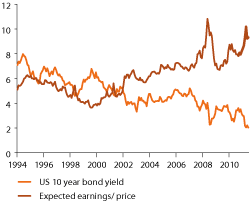Del 2
Topic article
6 Equity market returns
6.1 Introduction
The strategic benchmark of the Government Pension Fund Global (GPFG) comprises 60 percent equities. Consequently, developments in the equity market are of considerable importance to the overall return on the Fund. The annual return on the equity benchmark of the Fund from the first equity investments of the GPFG in 1998 and until the end of 2011 was 3.5 percent. The equity benchmark has registered an annual real rate of return of 1.6 percent, after deducting inflation of 1.9 percent, during the period. This is significantly less than the average real return in the equity market over the last 100 years. This article analyses the most important reasons for the low equity returns since 1998. The analysis looks at developments in company earnings, the payment of dividends to shareholders and changes in company valuations during the period.
Equities entitle the investor to a share of the future earnings of the company. The earnings may be paid directly to the shareholders in the form of dividends or reinvested in the form of new capital to fund its activities. The payment of dividends provides the shareholders with an immediate return. New investments lay the foundations for higher earnings in future. It is therefore common practice to evaluate the price of equities on the basis of the level of company earnings. The return on an equity investment may be separated into three sources:
dividends paid per share;
growth in company earnings per share; and
change in valuation, i.e. the ratio between the equity price and company earnings per share.
Historically, dividend payments and growth in company earnings have been the most important sources of equity returns over time. A study of the US equity market over the period 1926-2005 shows, for example, that 4.1 percentage points out of a real rate of return of 6.9 percent originated from dividend payments, whilst 1.9 percentage points derived from real growth in company earnings and only 0.7 percentage point from changes in valuations1. A corresponding analysis of the global equity market for the period 1998–2011 can provide useful insight into how this period deviates from long-term equity market trends. The below analysis shows that this period was one of good profitability on the part of listed companies and high growth in earnings per share. However, investors’ valuation of the equity market declined markedly through the period and is an important factor in explaining the weak returns.
6.2 Returns since 1998
Figure 6.1 A shows developments in earnings per share for the companies included in the equity market index MSCI All Country World Index (ACWI). This index reflects the global equity market. Earnings per share have increased by 6 percent per year since 1998, and were more than twice as high at the end of 2011 as in 1998. Adjusting for inflation, average real growth was 3.6 percent per year. This is higher than the historical average of 1.9 percent in the US equity market. However, profit levels have varied considerably over time. Consequently, the time period used may have a major impact on calculated earnings growth.
Figure 6.1 B shows developments in dividend payments from the companies in the index, measured as a percentage of the market value of the companies. The figure shows that the shareholders have on average received dividends corresponding to 2.2 percent of the market value of the equities. This is a lower direct rate of return than the historical average of 4.1 percent for the US equity market over the period 1926-2005.
The lower direct return needs to be examined in the context of the high growth in earnings per share. It has become more common for companies to repurchase own shares rather than pay dividends. When companies repurchase own shares, each of the remaining shares will represent a larger share of the overall earnings of such companies. Earnings per share will therefore grow. The repurchasing of equities is driven by a number of factors, but tax considerations have been important in large markets like the US.
All in all, developments in dividends and earnings per share nevertheless create the impression that company profitability has been good since 1998. This impression is substantiated by developments in companies’ return on equity, see figure 6.1 C. The return on equity shows how effective companies are in generating earnings on the capital shareholders have committed to them. The figure shows that the return on equity has fluctuated with the business cycle, but has averaged almost 12 percent since 1994. This means that companies have on average earned profits equivalent to almost 12 percent of equity. As the return on equity has not been significantly reduced since 1998, this indicates that the ability of companies to increase earnings per share and pay dividends has not changed significantly over the period.
Since 1994, there have been major changes in equity markets’ valuation of expected company earnings. From 1995 to 2000, equity prices increased from a multiple of 16 to a multiple of 27 on company earnings. Historically, the valuation was very high in 2000. These developments were in large part driven by strong growth in the equity valuation of companies within technology, telecommunications and media. These industries were perceived as being very well positioned for generating profit growth as the result of the technological changes resulting from, inter alia, the Internet. After 2000, equity prices went into a slump, and the equity market was priced at 10 times expected company earnings as per yearend 2011. These developments reduced the average annual return on equities by as much as 5 percentage points over the period 1998-2011.
All in all, the low returns in global equity markets since 1998 can to a large extent be explained by equity market valuations of company earnings having decreased significantly over this period. Companies’ growth in earnings per share has exceeded the historical average, whilst dividend payments have been somewhat lower. In aggregate, developments in dividends and earnings per share have not differed significantly from those in the past.

Figur 6.1 Growth in earnings per share, dividend yield, return on equity and price/expected earnings for the companies included in the equity index MSCI ACWI for the period 1994-2011
Kilde: MSCI.
The decline in the valuation of the equity market, particularly over the period since 2000, has been marked. Changes in equity market valuations will normally be related to changes in the level of risk-free interest rates, changes in the magnitude of the risk premium in the equity market and changes in investors’ expectations of growth in company earnings. It is therefore common practice to compare the interest rate on relatively low-risk bonds to the valuation of more uncertain earnings from limited companies. The difference between these two variables illustrates developments in market players’ expectations of the growth in company earnings and changes in the risk premium in the equity market. Figure 6.2 presents this by comparing the interest rate on US government bonds with a 10-year duration to the expected earnings of companies, divided by the market value of the equity market (the positions of the numerator and the denominator are reversed from those used in calculating the valuation of the equity market in figure 6.1 D).

Figur 6.2 The interest rate on US government bonds with a 10-year duration and the ratio between expected earnings per share and price over the next 12 months
Kilde: MSCI.
The figure shows that developments in valuation in these two markets were fairly similar to each other over the period from 1994 to 2002. However, the valuation of equities has declined quite considerably relative to the valuation of bonds over the last 10 years, particularly after the financial crisis. The steep decline in interest rates on bonds since 2007 has not been mirrored in the valuation of the equity market. Consequently, there is reason to believe that investors are more uncertain about developments in company earnings and/or require a higher expected excess return, using bond returns as the reference, in order to invest in equities than was previously the case.
Footnotes
Jones, C. P. (2008), “Analyzing and Estimating Real Stock Returns”, Journal of Portfolio Management Nr. 3.